Part 1 — An Economic Policy Based on Data be to nominate a High Officer for AI, as the British have done by setting up the Office for AI (OAI) in a bid to implement their recent strategy25 (see inset). Placed under the authority of the Minister for the Digital Sector (attached to the Prime Minister), this figure would be responsible for coordinating government policy, notably in terms of internal ministerial transformation and for forming the interface between the public and private sectors. They could call on the assistance of the administrations supervised by their ministry in order to perform this task. In line with profoundly interministerial logic, they would be responsible for the daily coordination of a network of contacts within the various ministries and administrations in order to accelerate implementation of the transformations. This coordinator could refer to the technical expertise of DINSIC (Direction interministérielle du numérique et du système d’information et de communication de l’État —Interministerial Directorate for Digital Technology and the Government Information and Communication System) in order to assist administrations in their understanding of AI. The British Office for AI The British government announced the creation of the Office for AI (OAI) following publication of its strategy last November. Its role is to initiate the transformation of public policies using artificial intelligence, to encourage the appropriation of AI tools in the private sector, and to forge strong links with the economic and academic worlds. Jointly led by the Department for Digital, Culture, Media & Sport and the Department for Business, Energy and Industrial Strategy, the OAI and its director are responsible for leading the operational implementation of the UK’s transformation strategy. Creating a Joint Centre of Excellence for AI at State Level Not all administrations possess the same level of maturity in terms of reflecting on the usage of AI in their specialist areas and their implementation processes. A major difficulty resides in the capacity to source the right skills for keeping up with the pace of innovation, identifying their applicability, and potentially transforming them into an initial proof of concept. In this context, public authorities must rely on an organization whose mission is both to recruit profiles adapted to AI transformations and to act as an advisor and a lab for public policy design. This is a temporary arrangement only: over time, these skills should exist and be sustainable within the various administrations, which should be able to recruit specialists in AI from their own sectors. DINSIC seems best placed to take on this role. With its directorate operating under supervision of the Prime Minister, DINSIC is currently responsible for coordinating the activities of administrations in terms of information systems. 25. Document available at the following address: https://www.gov.uk/government/uploads/system/uploads/attachment_data/file/664563/industrial- strategy-white-paper-web-ready-version.pdf 55
 For a Meaningful AI - Report Page 55 Page 57
For a Meaningful AI - Report Page 55 Page 57